Validation Analysis of Drought Monitoring Based on FY-4 Satellite
Abstract
:1. Introduction
2. Materials and Methods
2.1. Typical Drought Events
2.2. Data
2.3. Methods
2.3.1. Drought Indicator
2.3.2. Data Processing
2.3.3. Correlation Analysis
2.3.4. Trend Analysis
3. Results
3.1. Analysis of Spatial and Temporal Correlations
3.2. Analysis of Trend
3.2.1. Trend of Drought Indices
3.2.2. Trend of Drought Area
3.2.3. Difference in Drought Area
3.3. Comparison with Other Satellites
3.3.1. Comparison with Earth Observation Satellites
- Comparison with MODIS
- 2.
- Comparison with Landsat-8
3.3.2. Comparison with FY-4B
4. Discussion
4.1. Impact of Cloud Cover on Drought Monitoring
4.2. Variability of Different Drought Indices
4.3. Differences between FY-4A and Other Satellites
4.3.1. Differences with Earth Observation Satellite
4.3.2. Differences in FY Series Geostationary Meteorological Satellites
5. Conclusions
- (1)
- The strong negative correlation between TVDI and site MCI was 15% in the Huanghuai region, 6.5% in Yunnan Province, and 51.9% in Guangdong Province. The percentage of negative correlation between TVDI and pixel SHRI were 24.8%, 28.7%, and 40.7% in the Huanghuai region, Yunnan Province, and Guangdong Province. TVDI had a strong negative correlation with MCI and SHRI in the severe drought area.
- (2)
- The trends of TVDI, MCI, and SHRI were similar. The pixel difference between increased TVDI and decreased SHRI is −13.5% in the Huanghuai region, 12.8% in Yunnan Province, and 28.1% in Guangdong Province. The trends of proportion in drought areas on TVDI and SHRI during the drought process were consistent.
- (3)
- The drought area on TVDI was generally greater than the area of SHRI. The pixels difference between TVDI and SHRI are mainly in the Huanghuai region, Yunnan Province, and Guangdong Province, which are [5.16–28.3%], [16.93–25.22%], and [6.66–18.93%].
- (4)
- Comparing FY-4A TVDI and MODIS TVDI, the spatial distribution is consistent, but there are differences in the severe drought areas, and the monitored severe drought area was larger than MODIS, similar to MCI. FY-4A yielded a higher number of valid values, with 14,149 and 13,712 pixels, respectively. Similarly, we observed consistent spatial distribution of TVDI between Landsat-8 and FY-4A. FY-4A TVDI shows similar numerical distributions with Landsat-8 TVDI.
- (5)
- In a comparative analysis of TVDI calculations by FY-4A and FY-4B, the LST’s differences were mainly concentrated in [−10, 15], with the median around 3. The NDVI’s differences were concentrated in [−0.05, 0.27], with the median around 0.15.
Author Contributions
Funding
Institutional Review Board Statement
Informed Consent Statement
Data Availability Statement
Acknowledgments
Conflicts of Interest
References
- Xie, X.Y.; Li, A.N. Development of a topographic-corrected temperature and greenness model (TG) for improving GPP estimation over mountainous areas. Agric. For. Meteorol. 2020, 295, 108193–108205. [Google Scholar] [CrossRef]
- Karamesouti, M.; Panagos, P.; Kosmas, C. Model-based spatio-temporal analysis of land desertification risk in Greece. Catena 2018, 167, 266–275. [Google Scholar] [CrossRef]
- Zhu, X.; Xu, Z.; Liu, Z.; Liu, M.; Yin, Z.; Yin, L.; Zheng, W. Impact of dam construction on precipitation: A regional perspective. Mar. Freshw. Res. 2022, 74, 877–890. [Google Scholar] [CrossRef]
- Li, J.; Wang, Z.; Lai, C. Severe drought events inducing large decrease of net primary productivity in China’s mainland during 1982–2015. Sci. Total Environ. 2020, 703, 135541. [Google Scholar] [CrossRef] [PubMed]
- Li, Q.; He, P.; He, Y.; Han, X.; Zeng, T.; Lu, G.; Wang, H. Investigation to the relation between meteorological drought and hydrological drought in the upper Shaying River Basin using wavelet analysis. Atmos. Res. 2020, 234, 104743. [Google Scholar] [CrossRef]
- Xie, X.Y.; Li, A.N. An Adjusted Two-Leaf Light Use Efficiency Model for Improving GPP Simulations Over Mountainous Areas. J. Geophys. Res. Atmos. 2020, 125, e2019JD031702. [Google Scholar] [CrossRef]
- Vicente-Serrano, S.M.; López-Moreno, J.I. Hydrological response to different time scales of climatological drought: An evaluation of the Standardized Precipitation Index in a mountainous Mediterranean basin. Hydrol. Earth Syst. Sci. 2005, 9, 523–533. [Google Scholar] [CrossRef] [Green Version]
- Wei, K.; Ouyang, C.; Duan, H.; Li, Y.; Chen, M.; Ma, J.; An, H.; Zhou, S. Reflections on the Catastrophic 2020 Yangtze River Basin Flooding in Southern China. Innovation 2020, 1, 100038. [Google Scholar] [CrossRef]
- Chen, Z.; Liu, Z.; Yin, L.; Zheng, W. Statistical analysis of regional air temperature characteristics before and after dam construction. Urban Clim. 2022, 41, 101085. [Google Scholar] [CrossRef]
- Liu, Z.; Xu, J.; Liu, M.; Yin, Z.; Liu, X.; Yin, L.; Zheng, W. Remote sensing and geostatistics in urban water-resource monitoring: A review. Mar. Freshw. Res. 2023, 74, 747–765. [Google Scholar] [CrossRef]
- Li, Y.; Si, Y.; Tong, Z.; He, L.; Zhang, J.; Luo, S.; Gong, Y. MQANet: Multi-Task Quadruple Attention Network of Multi-Object Semantic Segmentation from Remote Sensing Images. Remote Sens. 2022, 14, 6256–6280. [Google Scholar] [CrossRef]
- Rhee, J.; Im, J.; Carbone, G.J. Monitoring agricultural drought for arid and humid regions using multi-sensor remote sensing data. Remote Sens. Environ. 2010, 114, 2875–2887. [Google Scholar] [CrossRef]
- He, L.; Peng, B.; Tang, D.; Li, Y. Road Extraction Based on Improved Convolutional Neural Networks with Satellite Images. Appl. Sci. 2022, 12, 10800–10811. [Google Scholar] [CrossRef]
- Anderson, M.; Kustas, W. Thermal Remote Sensing of Drought and Evapotranspiration. Eos Trans. Am. Geophys. Union 2008, 89, 233–240. [Google Scholar] [CrossRef]
- Mishra, A.K.; Singh, V.P. A review of drought concepts. J. Hydrol. 2010, 391, 202–216. [Google Scholar] [CrossRef]
- Xia, L.; Zhao, F.; Mao, K.B.; Yuan, Z.J.; Zuo, Z.Y.; Xu, T.R. SPI-Based Analyses of Drought Changes over the Past 60 Years in China’s Major Crop-Growing Areas. Remote Sens. 2018, 10, 171–186. [Google Scholar] [CrossRef] [Green Version]
- Mckee, T.B.; Doesken, N.J.; Kleist, J. The Relationship of Drought Frequency and Duration to Time Scales. In Proceedings of the Eighth Conference on Applied Climatology, Anaheim, CA, USA, 12–22 January 1993. [Google Scholar]
- Zhang, J.; Sun, F.; Lai, W.; Lim, W.H.; Liu, W.; Wang, T.; Wang, P. Attributing changes in future extreme droughts based on PDSI in China. J. Hydrol. 2019, 573, 607–615. [Google Scholar] [CrossRef]
- Vicente-Serrano, S.M.; Beguería, S.; López-Moreno, J.I. A Multiscalar Drought Index Sensitive to Global Warming: The Standardized Precipitation Evapotranspiration Index. J. Clim. 2010, 23, 1696–1718. [Google Scholar] [CrossRef] [Green Version]
- Won, J.; Choi, J.; Lee, O.; Kim, S. Copula-based Joint Drought Index using SPI and EDDI and its application to climate change. Sci. Total Environ. 2020, 744, 140701. [Google Scholar] [CrossRef] [PubMed]
- Peng, Y.; Li, F.D.; Xu, N.; Rashid, K.; Gao, K.C.; Wang, G.Q.; Zhang, Y.Y.; Qiao, Y.F.; Li, Y.H.; Yang, H.; et al. Spatial-temporal variations in drought conditions and their climatic oscillations in Central Asian from 1990 to 2019. Chin. J. Eco-Agric. 2021, 29, 312–324. [Google Scholar]
- Wu, B.F.; Ma, Z.H.; Yan, N. Agricultural drought mitigating indices derived from the changes in drought characteristics. Remote Sens. Environ. 2020, 244, 111813–111830. [Google Scholar] [CrossRef]
- Rouse, J.W.; Haas, R.H.; Schell, J.A.; Deering, D.W. Monitoring Vegetation Systems in the Great Plains with Erts. NASA Spec. Publ. 1974, 351, 309. [Google Scholar]
- Kogan, F.; Sullivan, J. Development of global drought-watch system using NOAA/AVHRR data. Adv. Space Res. 1993, 13, 219–222. [Google Scholar] [CrossRef]
- Wang, P.X.; Ya, G.J.; Li, X.W.; Wang, J.D. Advances in Drought Monitoring by Using Remotely Sensed Normalized Difference Vegetation Index and Land Surface Temperature Products. Adv. Earth Sci. 2003, 18, 527–533. [Google Scholar]
- Kang, Y.; Guo, E.L.; Wang, Y.F.; Bao, Y.L.; Bao, Y.H.; Na, R. Application of temperature vegetation dryness index for drought monitoring in Mongolian Plateau. J. Appl. Ecol. 2021, 32, 2534–2544. [Google Scholar]
- Huete, A.R. A soil-adjusted vegetation index (SAVI). Remote Sens. Environ. 1988, 25, 295–309. [Google Scholar] [CrossRef]
- Liu, Y.; Wu, L.X.; Ma, B.D. Remote sensing monitoring of soil Moisture on the basis of TM/ETM+ spectral space. J. China Univ. Min. Technol. 2013, 42, 296–301. [Google Scholar]
- Phillips, C.G. An Evaluation of Ecosystem Management and Its Application to the National Environmental Policy Act: The Case of the U.S. Forest Service. Agric. Syst. 1997, 108, 84–93. [Google Scholar]
- He, L.; Cheng, Y.; Li, Y.; Li, F.; Fan, K.; Li, Y. An Improved Method for Soil Moisture Monitoring With Ensemble Learning Methods Over the Tibetan Plateau. IEEE J. Sel. Top. Appl. Earth Obs. Remote Sens. 2021, 14, 2833–2844. [Google Scholar] [CrossRef]
- Sandholt, I.; Rasmussen, K.; Andersen, J. A simple interpretation of the surface temperature/vegetation index spacefor assessment of surface moisture status. Remote Sens. Environ. 2002, 79, 1710–1721. [Google Scholar] [CrossRef]
- Chen, Z.; Huang, W.; Shi, L.Y.; Qi, X.H. Analysis of differences in agricultural drought monitoring based on different TVDI indices in Fujian Province in 2018. J. Nat. Disasters 2021, 30, 233–243. [Google Scholar]
- Sha, S.; Wang, Y.; Wang, L.J.; Hu, D. Research of Application of Land Use Data to TVDI Method on Drought Monitoring in the Eastern Region of Gansu. Res. Soil Water Conserv. 2017, 24, 375–381. [Google Scholar]
- Xu, L.; Abbaszadeh, P.; Moradkhani, H.; Chen, N.; Zhang, X. Continental drought monitoring using satellite soil moisture, data assimilation and an integrated drought index. Remote Sens. Environ. 2020, 250, 112028–112044. [Google Scholar] [CrossRef]
- Yu, H.Z.; Li, L.J.; Li, J.Y. Establishment of comprehensive drought monitoring model based on downscaling TRMM and MODIS data. J. Nat. Resour. 2020, 35, 2553–2568. [Google Scholar] [CrossRef]
- Urban, M.; Berger, C.; Mudau, T.E.; Heckel, K.; Truckenbrodt, J.; Odipo, V.O.; Smit, I.P.J.; Schmullius, C. Surface Moisture and Vegetation Cover Analysis for Drought Monitoring in the Southern Kruger National Park Using Sentinel-1, Sentinel-2, and Landsat-8. Remote Sens. 2018, 10, 1482–1491. [Google Scholar] [CrossRef] [Green Version]
- Chen, X.; Liu, M.; Li, D.; Jia, J.; Yang, A.; Zheng, W.; Yin, L. Conv-trans dual network for landslide detection of multi-channel optical remote sensing images. Front. Earth Sci. 2023, 11, 1182145. [Google Scholar] [CrossRef]
- Yin, L.; Wang, L.; Keim, B.D.; Konsoer, K.; Zheng, W. Wavelet Analysis of Dam Injection and Discharge in Three Gorges Dam and Reservoir with Precipitation and River Discharge. Water 2022, 14, 567. [Google Scholar] [CrossRef]
- Goodarzi, M.R.; Pooladi, R.; Niazkar, M. Evaluation of Satellite-Based and Reanalysis Precipitation Datasets with Gauge-Observed Data over Haraz-Gharehsoo Basin, Iran. Sustainability 2022, 14, 13051. [Google Scholar] [CrossRef]
- Goodarzi, M.R.; Sabaghzadeh, M.; Niazkar, M. Evaluation of Snowmelt Impacts on Flood Flows Based on Remote Sensing Using SRM Model. Water 2023, 15, 1650. [Google Scholar] [CrossRef]
- Dubovik, O.; Schuster, G.L.; Xu, F.; Hu, Y.; Bösch, H.; Landgraf, J.; Li, Z. Grand Challenges in Satellite Remote Sensing. Front. Remote Sens. 2021, 2, 619818. [Google Scholar] [CrossRef]
- Wang, G.Q.; Shen, X. The FY-4 radiometer imager and the application of its data in satellite meteorology. Chin. J. Nat. 2018, 40, 1–11. [Google Scholar]
- Hu, T.; van Dijk, A.I.J.M.; Renzullo, L.J.; Xu, Z.; He, J.; Tian, S.; Zhou, J.; Li, H. On agricultural drought monitoring in Australia using Himawari-8 geostationary thermal infrared observations. Int. J. Appl. Earth Obs. Geoinf. 2020, 91, 102153–102165. [Google Scholar] [CrossRef]
- Barbosa, H.A.; Lakshmi Kumar, T.V.; Paredes, F.; Elliott, S.; Ayuga, J.G. Assessment of Caatinga response to drought using Meteosat-SEVIRI Normalized Difference Vegetation Index (2008–2016). ISPRS J. Photogramm. Remote Sens. 2019, 148, 235–252. [Google Scholar] [CrossRef]
- Li, Y.N.; Yu, W.J.; Xie, T.; Zhou, H.Z. Drought Disaster Monitoring and Drought Analysis Based on FY-4 AGRI and Himawari-8 AHI—A Case Study of the autumn drought in Hebei Province in 2018. J. Catastrophol. 2019, 34, 228–234. [Google Scholar]
- Aihua, L.; Yanchen, B. Comparison of Multi source Remote Sensing Thematic Information: Progresses, Problems and Prospects. Adv. Earth Sci. 2011, 26, 741. [Google Scholar]
- Zhao, Q.; Yu, L.; Du, Z.; Peng, D.; Hao, P.; Zhang, Y.; Gong, P. An Overview of the Applications of Earth Observation Satellite Data: Impacts and Future Trends. Remote Sens. 2022, 14, 1863. [Google Scholar] [CrossRef]
- Goodarzi, M.; Fatehifar, A.; Avazpoor, F. Bivariate Analysis of the Impact of Climate Change on Drought with SPEI Index and Coppola Functions (Case Study: Dugonbadan). Iran-Water Resour. Res. 2020, 15, 352–365. [Google Scholar]
- Zhang, C.; Wang, S.; Song, Y.; Cai, W. Research of Drought Risk Assessment for Winter Wheat in Northern China. J. Arid. Meteorol. 2014, 32, 883–893. [Google Scholar]
- Wang, S.; Zhang, C.; Song, L.; Li, Y.; Feng, J.; Wang, J. Relationship Between Soil Relative Humidity and the Multiscale Meteorological Drought Ilndexes. J. Glaciol. Geocryol. 2013, 35, 865–873. [Google Scholar]
- Qi, S.H.; Wang, C.Y.; Niu, Z. Evaluting Soil Moisture Status in China Using the Temperature/vegetation Dryness Index (TVDI). Natl. Remote Sens. Bull. 2003, 30, 420–427+436. [Google Scholar]
- GB/T 32136-2015; Grade of Agricultural Drought. National Standards of People’s Republic of China: Beijing, China, 2015; p. 20.
- GB/T 20481-2017; Grades of Meteorological Drought. National Standards of People’s Republic of China: Beijing, China, 2017; p. 32.
- Bofeng, C.; Rong, Y. Advance and evaluation in the long time series vegetation trends research based on remote sensing. Natl. Remote Sens. Bull. 2009, 13, 1170–1186. [Google Scholar]
- Goodarzi, M.R.; Sabaghzadeh, M.; Mokhtari, M.H. Impacts of aspect on snow characteristics using remote sensing from 2000 to 2020 in Ajichai-Iran. Cold Reg. Sci. Technol. 2022, 204, 103682. [Google Scholar] [CrossRef]
- Shang, H.Z.; Hussletu; Li, M.; Tao, J.H.; Chen, L.F. Remote Sensing of Cloud Properties Based on Visible-to-Ifrared Channel Observations from Passive Remote Sensing Satellites. Acta Opt. Sin. 2022, 42, 37–52. [Google Scholar]
- Yang, J.; Guo, X.; Qu, J.; Han, M. An FY-4A/AGRI cloud detection model based on the naive Bayes algorithm. Remote Sens. Nat. Resour. 2022, 34, 33–42. [Google Scholar]
- Zhang, D.; Yang, S.; Wang, Y.; Sun, L.; Gao, Y.; Zhu, H.; Ye, Q.Y. Assessing drought conditions over cloudy regions based on FY3C/VIRR LST. J. Nat. Resour. 2021, 36, 1047–1061. [Google Scholar] [CrossRef]
- Lu, Z.; Lei, G.P.; Ma, Q.L.; Guo, J.P.; Wang, J.W. Regional Drought Monitoring Based on Reconstructed Landsat 8 Data and Temperature Vegetation Index. Res. Soil Water Conserv. 2018, 25, 271–277+384. [Google Scholar]
- Wang, Z.D.; Guo, P.; Wan, H.; Yang, G. Analysis of Drought Monitoring in Shandong Province from 2014 to 2016 Based on MODIS Data. Res. Soil Water Conserv. 2019, 26, 330–336. [Google Scholar]
- Li, Y.; Peng, B.; He, L.; Fan, K.; Tong, L. Road segmentation of unmanned aerial vehicle remote sensing images using adversarial network with multiscale context aggregation. IEEE J. Sel. Top. Appl. Earth Obs. Remote Sens. 2019, 12, 2279–2287. [Google Scholar] [CrossRef]
- Xue, H.Z.; Li, Y.Y.; Dong, G.T. Analysis of Spatial-temporal Variation Characteristics of Meteorological Drought in the Hexi Corridor Based on SPEI index. Chin. J. Agrometeorol. 2022, 43, 923–934. [Google Scholar]
- Qu, X.B.; Wu, H.; Yue, K.; Liu, P.T.; Li, X.R. Comparison of 4 Remote Sensing Drought Indexes for Drought Monitoring in Eastern Inner Mongolia. J. Ecol. Rural. Environ. 2020, 36, 81–88. [Google Scholar]
- Wei, W.; Wenbin, W.; Qingbo, Z.; Mingwei, Z. Analysis and Calibration of Spectral Response Difference Effects on Measured NDVI with Separate Satellite Sensors. Remote Sens. Inf. 2015, 30, 91–98. [Google Scholar]
- Zhang, P.; Zhu, L.; Tang, S.; Gao, L.; Chen, L.; Zheng, W.; Han, X.; Chen, J.; Shao, J. General Comparison of FY-4A/AGRI with Other GEO/LEO Instruments and Its Potential and Challenges in Non-meteorological Applications. Front. Earth Sci. 2019, 6, 224. [Google Scholar] [CrossRef] [Green Version]

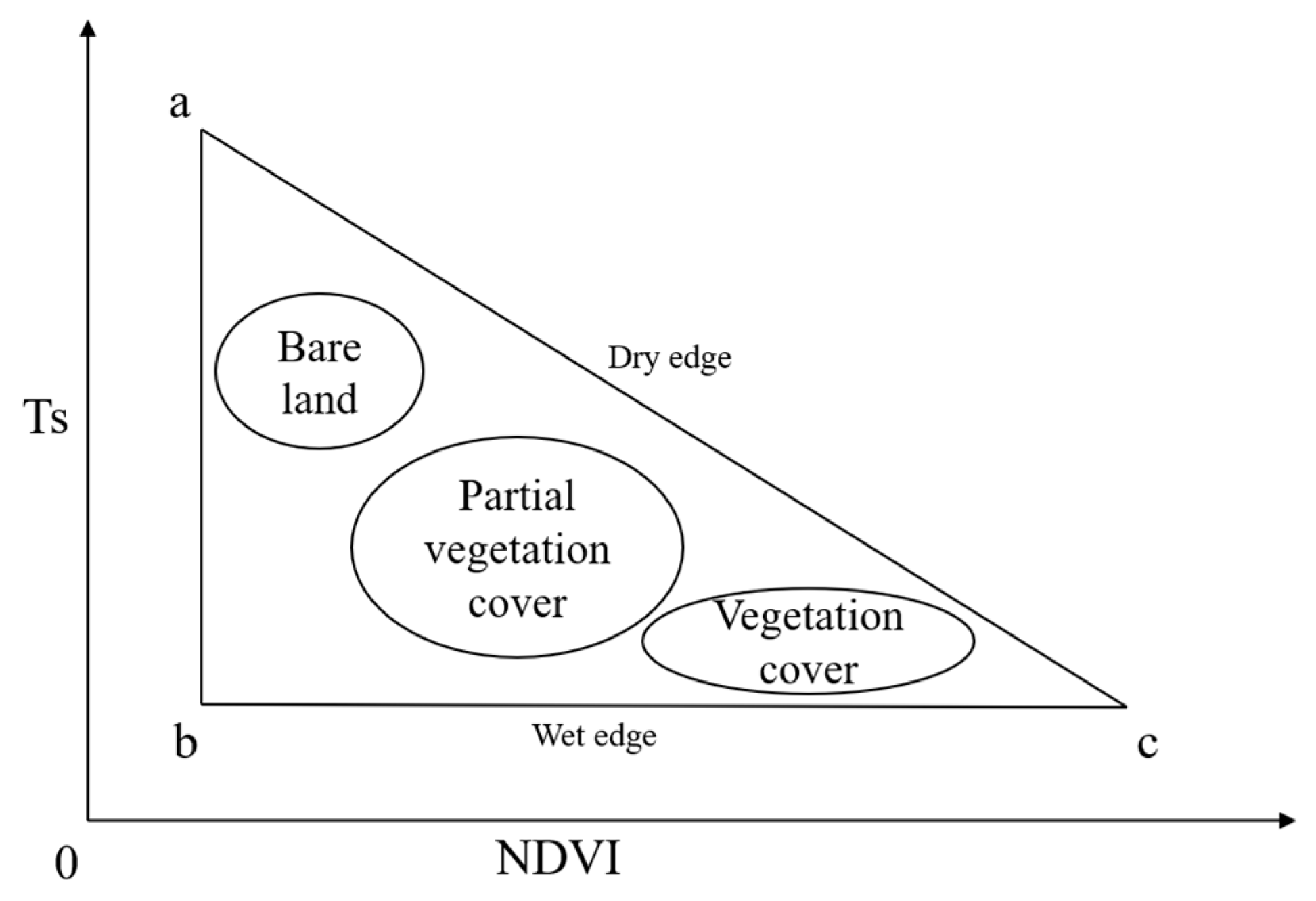
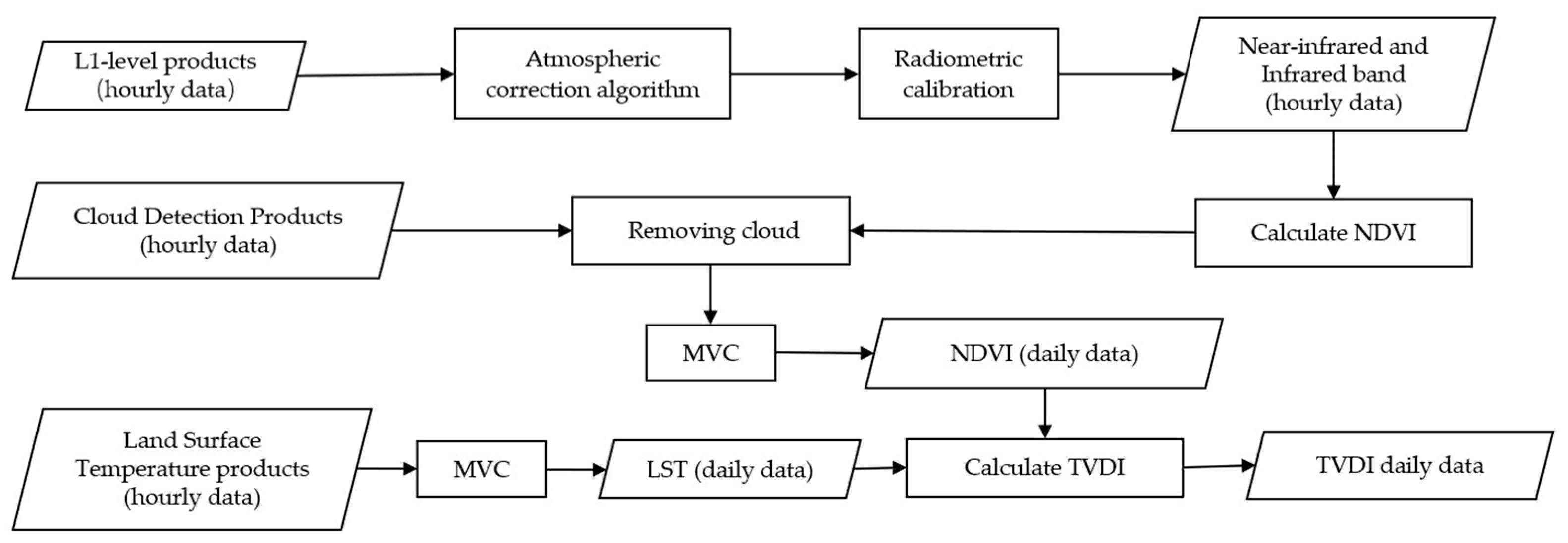
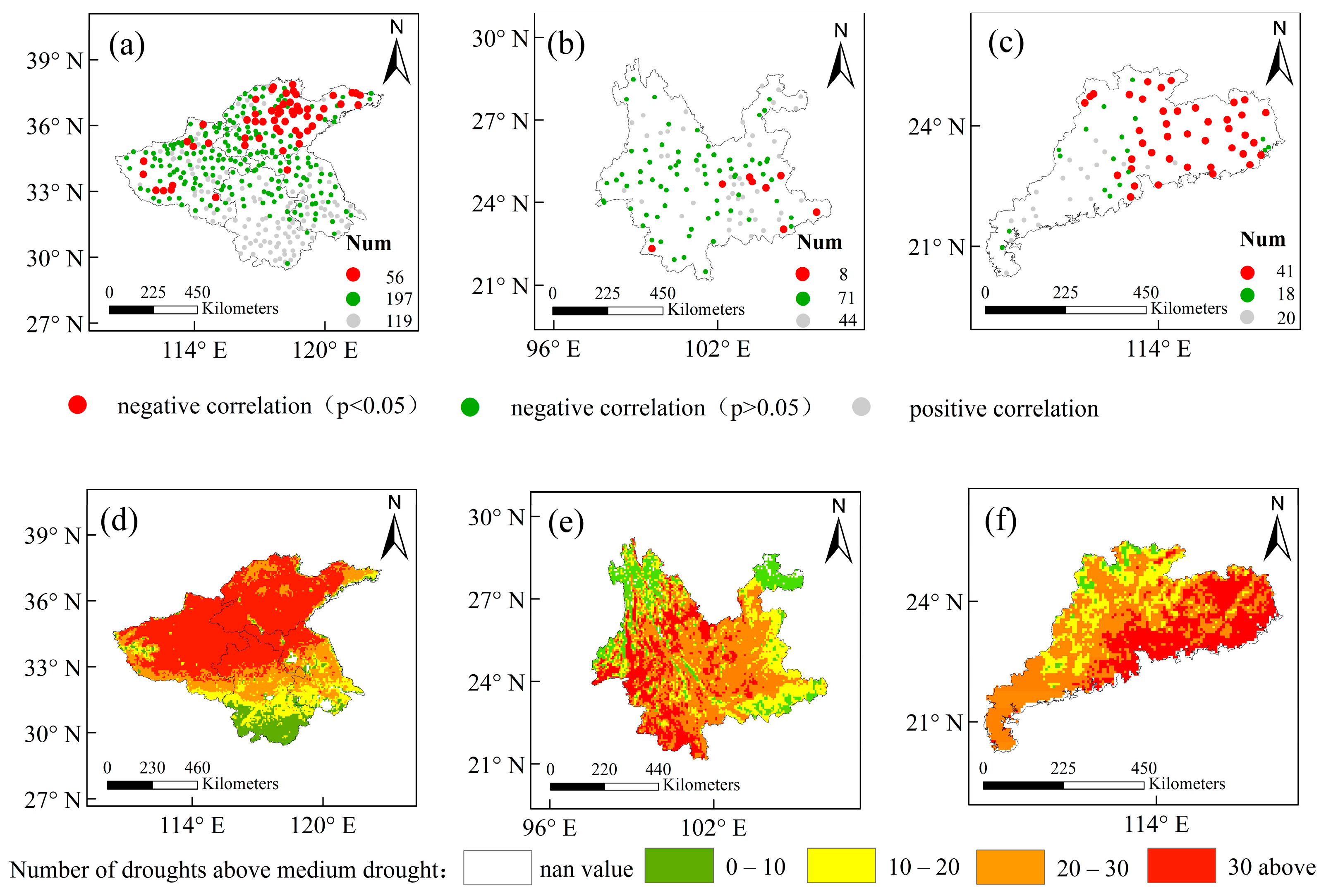



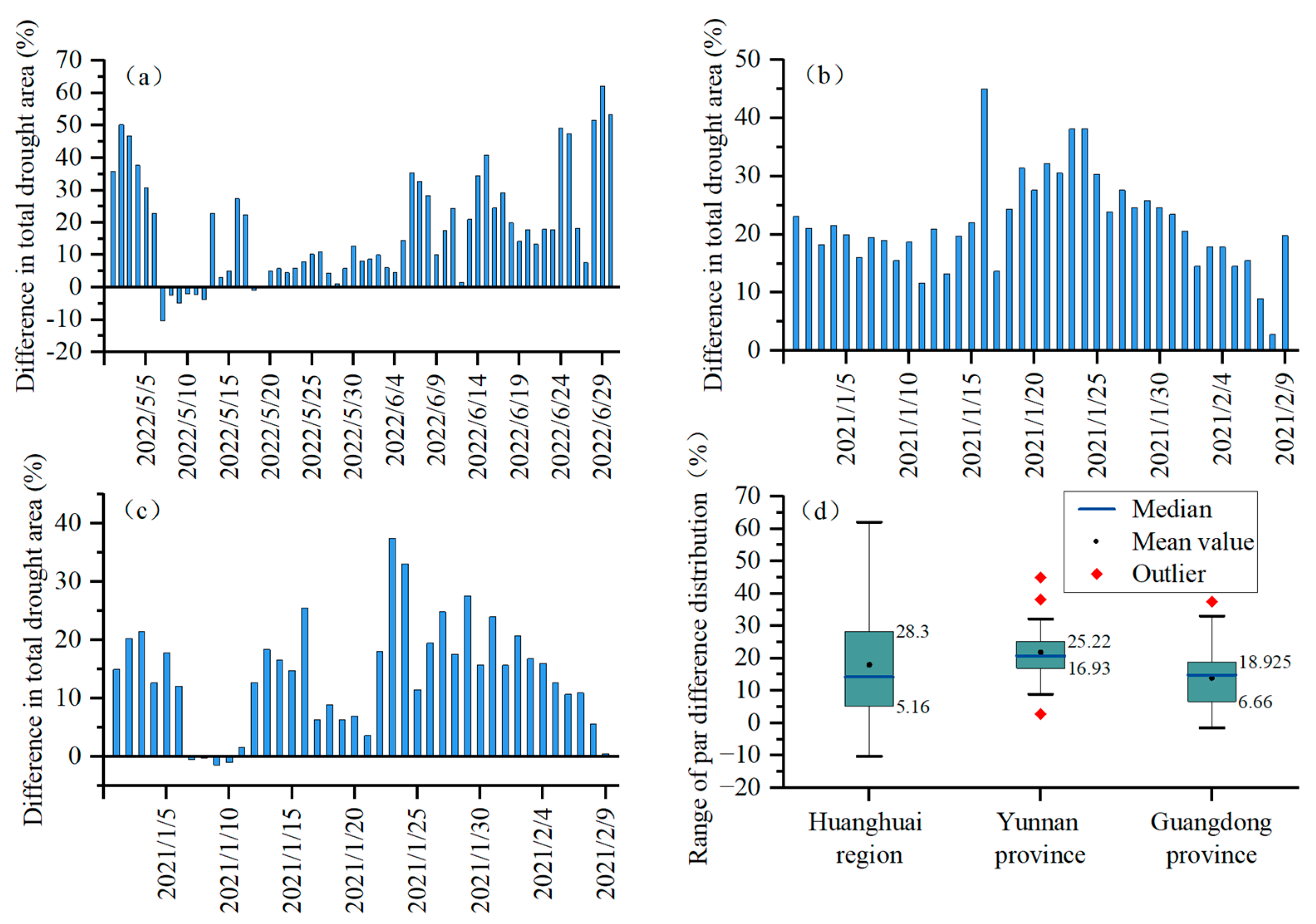



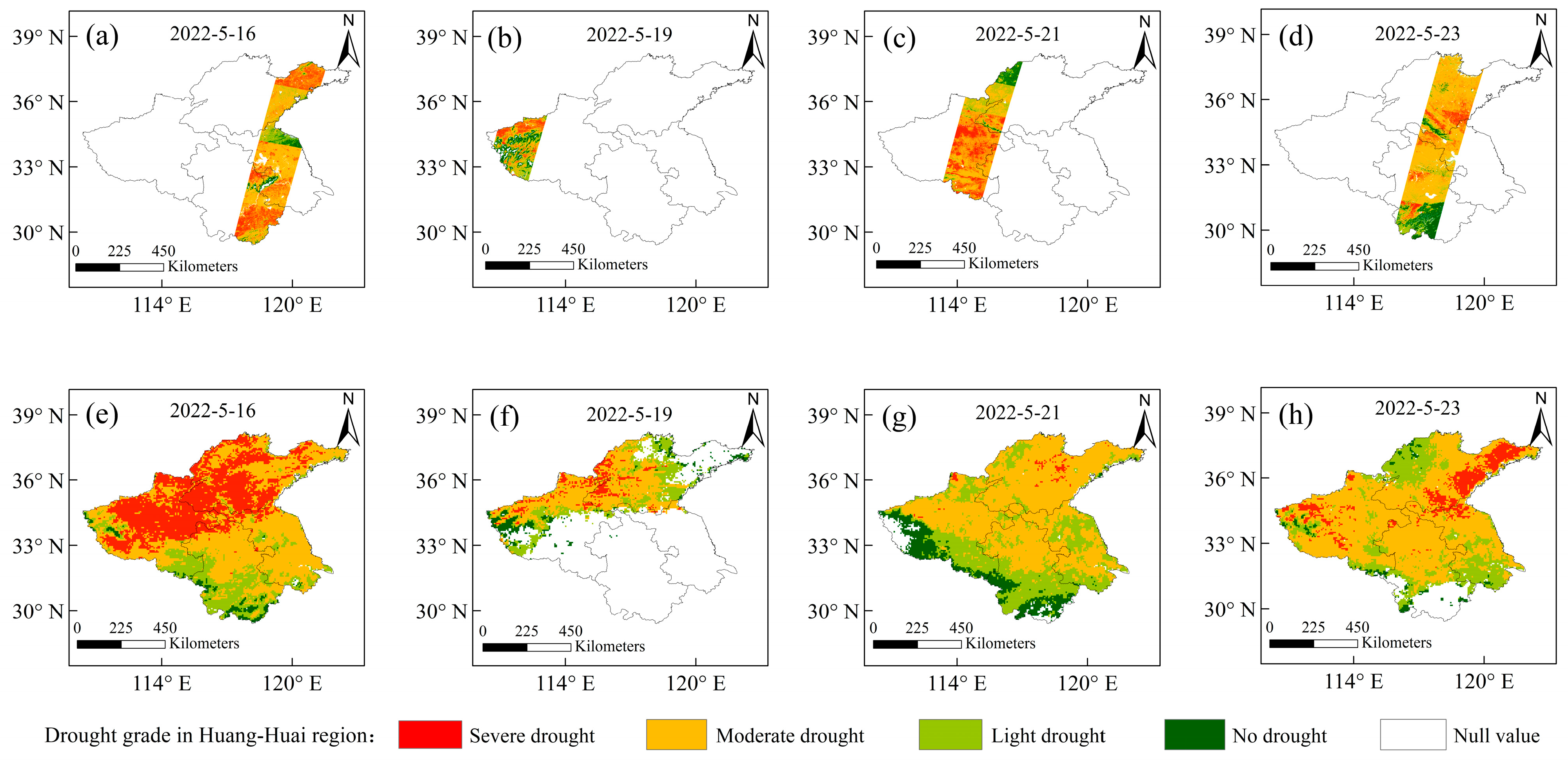

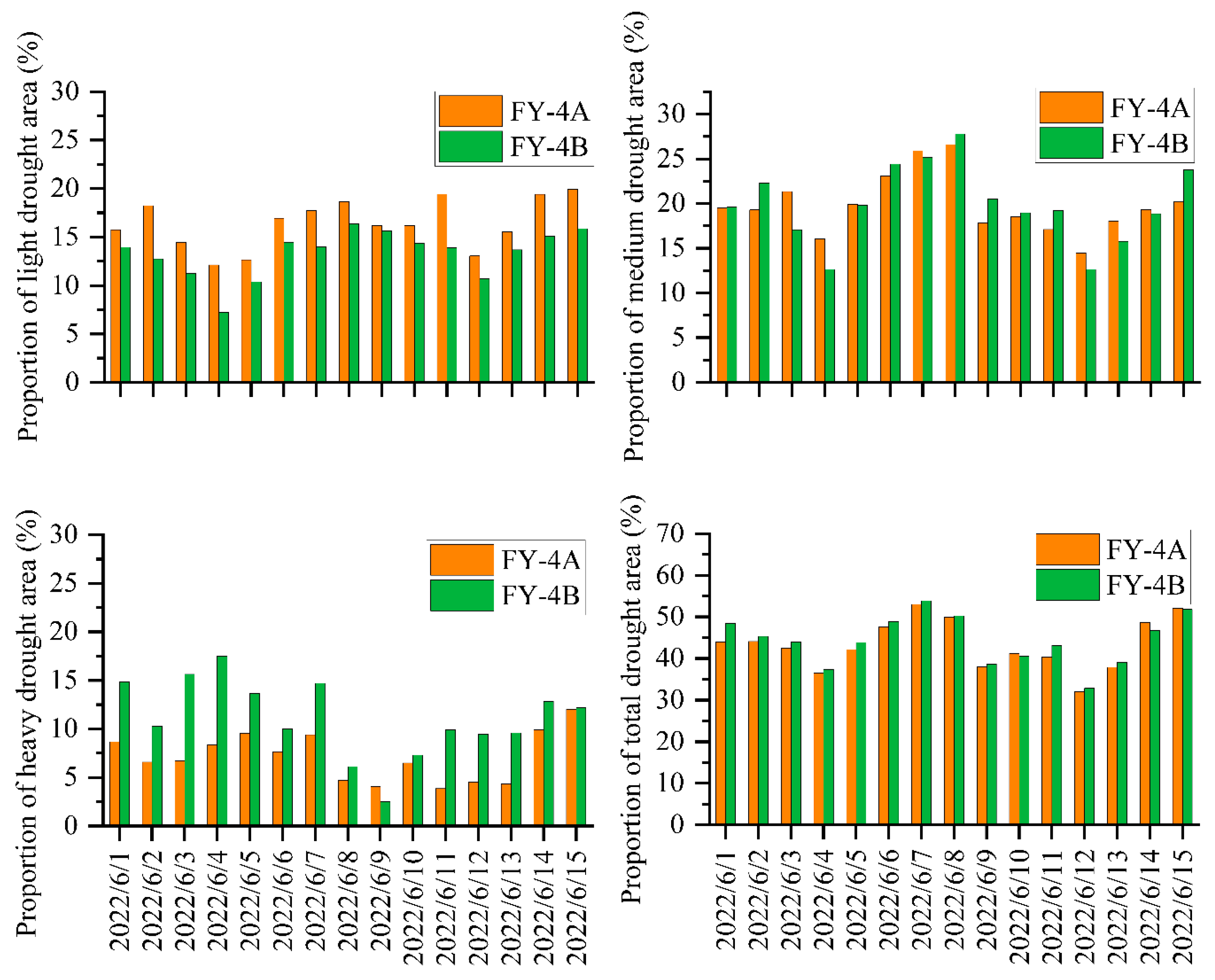
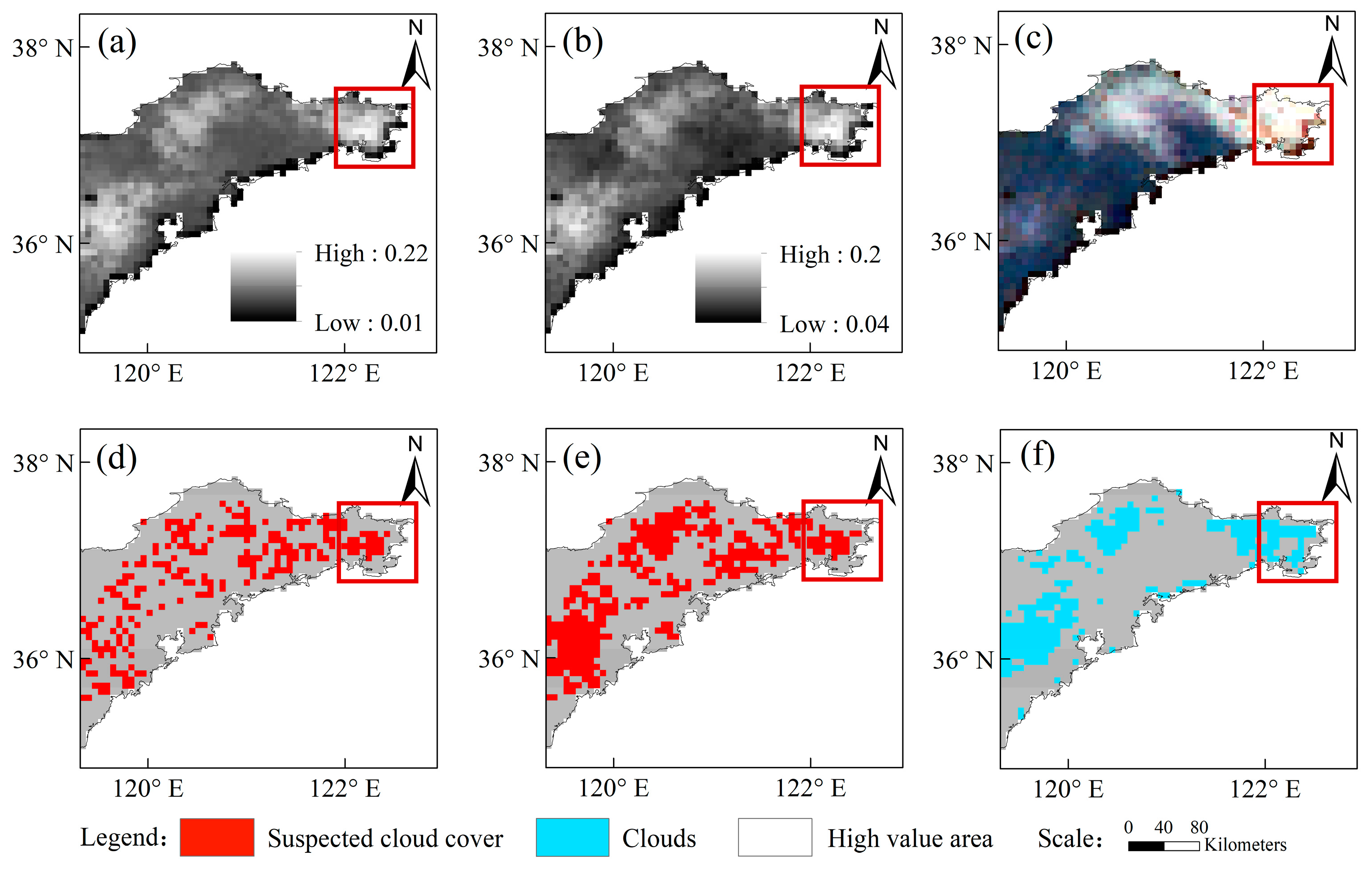
| Drought Type | TVDI | MCI | SRHI (%) |
|---|---|---|---|
| Drought free | [0, 0.4] | (−0.5, +∞) | [60, 100] |
| Light drought | (0.4, 0.6] | (−1, −0.5] | [50, 60) |
| Moderate drought | (0.6, 0.8] | (−1.5, −1] | [40, 50) |
| Severe drought | (0.8, 1] | (−2, −1.5] | [30, 40) |
| Extreme drought | - | (−∞, −2] | [0, 30) |
| Datasets | Band (Products) | Temporal Resolution | Spatial Resolution | Wavelength Band (µm) |
|---|---|---|---|---|
| MODIS | Red | 1, 8, 16 days | 250 m | 0.620–0.670 |
| NIR | 250 m | 0.841–0.876 | ||
| LST | 8 days | 1000 m | - | |
| Landsat-8 | Red | 16 days | 30 m | 0.64–0.67 |
| NIR | 30 m | 0.85–0.88 | ||
| TIRS 1 | 30 m | 10.6–11.19 | ||
| FY-4A | Red | 15 min | 500 m | 0.55–0.75 |
| NIR | 1000 m | 0.75–0.90 | ||
| LST | 4000 m | - |
| Datasets | Num of Images | Standard Deviation | RMSE (with FY-4A) | Value Range | Processing Time (min) |
|---|---|---|---|---|---|
| MODIS | 4/2 days | 0.15 | 0.26 | [0.13, 0.97] | 5.56 |
| Landsat-8 | 35/16 days | 0.35 | 0.13 | [0.08, 0.93] | 17.31 |
| FY-4A | 4/h 165/day | 0.26 | - | [0.02, 0.98] | 3.15 |
Disclaimer/Publisher’s Note: The statements, opinions and data contained in all publications are solely those of the individual author(s) and contributor(s) and not of MDPI and/or the editor(s). MDPI and/or the editor(s) disclaim responsibility for any injury to people or property resulting from any ideas, methods, instructions or products referred to in the content. |
© 2023 by the authors. Licensee MDPI, Basel, Switzerland. This article is an open access article distributed under the terms and conditions of the Creative Commons Attribution (CC BY) license (https://creativecommons.org/licenses/by/4.0/).
Share and Cite
Luo, H.; Ma, Z.; Wu, H.; Li, Y.; Liu, B.; Li, Y.; He, L. Validation Analysis of Drought Monitoring Based on FY-4 Satellite. Appl. Sci. 2023, 13, 9122. https://doi.org/10.3390/app13169122
Luo H, Ma Z, Wu H, Li Y, Liu B, Li Y, He L. Validation Analysis of Drought Monitoring Based on FY-4 Satellite. Applied Sciences. 2023; 13(16):9122. https://doi.org/10.3390/app13169122
Chicago/Turabian StyleLuo, Han, Zhengjiang Ma, Huanping Wu, Yonghua Li, Bei Liu, Yuxia Li, and Lei He. 2023. "Validation Analysis of Drought Monitoring Based on FY-4 Satellite" Applied Sciences 13, no. 16: 9122. https://doi.org/10.3390/app13169122






